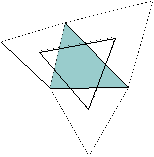Appendix 2
Excerpt from (W Roberts, 2003) reformatted for web presentation.
Napoleon's Theorem
The closest theorem I have thus far found to the theorems I discovered in 1998 (and that I have termed the Eutrigon and Co-eutrigon Theorems (W. Roberts, 2003, pp. 121—135) is known as Napoleon’s Theorem. Apparently Napoleon Bonaparte had a strong interest in geometry and this theory has been attributed to him.
‘If equilateral triangles are erected externally on the sides of any triangle, their centers form an equilateral triangle.’ (HSM Coxeter & SL Greitzer,1967, pp. 63).

Figure A-2.1 Note the equilateral triangle ...which is always formed by joining the centres of the equilateral triangles erected externally around any triangle’s edges.
Similarly, if equilateral triangles are erected internally (or centripetally) around the sides of any triangle as in Figure A-2.2, their centres also form an equilateral triangle known as the inner Napoleon triangle (HSM Coxeter & SL Greitzer,1967, pp. 63).

We do not prove it here, but the difference in area between the outer and inner Napoleon triangles around any triangle is equal to the area of the original triangle in question (HSM Coxeter & SL Greitzer,1967).
If we combine the Napoleon Theorem with the new relative unit of area (the etu), we see a most interesting relation,
If the area of a triangle is integral (in terms of etu) then it is the difference of two ‘perfect squares’ (p2 – q2), representing the difference in areas of the outer and inner napoleon triangles expressed in etu.